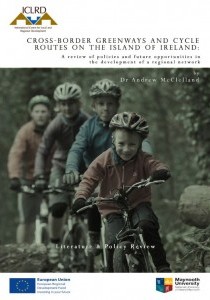The capacity for cycling and the associated physical infrastructure of greenways and cycle routes to intersect with, and influence, a range of policy agendas, is widely acknowledged, including within key public policy documents in both jurisdictions on the island of Ireland. Indeed, broadly speaking, the policy environment appears to have shifted markedly in favour of cycling and other forms of sustainable transport within the last half-decade. Apart from the social, environmental, health and other benefits of cycling, there is also an increasing recognition of the economic potential of cycling – as demonstrated by the early stages of the Giro d’Italia cycle race on the island of Ireland in May 2014. However, the development of a cycling culture on the island of Ireland and the associated physical infrastructure consisting of greenways and cycle routes has lagged somewhat behind many other European countries. In particular, the car has predominated as the principal mode of transport of citizens in both jurisdictions.
 |
Title: Cross-Border Greenways and Cycle Routes on the Island of Ireland: A review of policies and future opportunities in the development of a regional network |
| Publication Date: December 2014 |
Author: Dr. Andrew McClelland
|
| Funding: INTERREG IVA administered by the SEUPB. |
| Summary: A key purpose of this report is to review national, regional and local policies and potential opportunities relating to greenways and cycle routes on the island of Ireland so as to support local authorities and others in the development of a region-wide greenway and cycle route network on a cross-border basis. This report considers the academic and policy literature relating to cycling and the development of greenways and cycle routes on the island of Ireland. It places a particular emphasis on the opportunities for cross-border cooperation in the creation of a ‘joined-up’ regional network of cycling routes. The multiple benefits of cycling and cycle route development are underlined, including in relation to health, the environment, economy and the creation of shared public spaces; as is the importance of spatial planning to sustainable transport policies. |
 |


